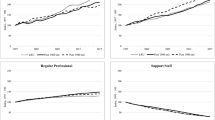Abstract
The real compensation of senior university administrators in Ontario has increased by over 43% in the last decade. The escalation is especially pronounced for presidents and provosts: their pay has risen by 63% in real terms between 1996 and 2006. These trends have been evident in universities of all types, for both genders and for professional as well as non-professional faculties. Besides documenting this hitherto unnoticed phenomenon, we explore the determinants of this escalation. Increased university size, and the consequent complication of administrators’ duties undoubtedly plays some role in the increase, though it likely does not explain all of it. Increased competition in the market for senior administrators may be contributing to the escalation, as may heightened rent-seeking behaviour.









Similar content being viewed by others
Notes
The double cohort resulted from the shortening of Ontario’s high school curriculum from 5 to 4 years. This led to two cohorts of students entering university in 2003. Anticipating greater difficulty in obtaining a university place, many students under the old 5 year curriculum “fast-tracked”, i.e., completed high school in 4, rather than 5 years.
Consider a situation where Dr. X moves from being the Provost at University A to the same position at University B. Dr. X would get separate fixed effects for her tenure at University A and B. Also, suppose Dr. Y start of as Dean of Arts at University C, but is then promoted to be the vice-president of research; she would get one fixed effect indicating her time as Dean, and another for her time as vice-president.
The mean budget per student varies from $8,454 at Wilfrid Laurier to $16,676 at Queen’s.
Unfortunately, our data set does not contain information on previous employment. An informal survey suggests, however, that private sector transplants mainly serve in the positions of VP Advancement and Finance, and as business school deans.
The trends for provosts and presidents are very similar.
The slow growing universities are Lakehead, Queen’s, Windsor, Western, Carleton, Laurentian and York. The fast growing universities are Waterloo, McMaster, Ryerson, Guelph, Toronto, Ottawa, Trent, Brock and Wilfrid Laurier. Lakehead grew the least; its enrollments increased 8.5% between 1996 and 2006. Wilfrid Laurier grew the most; its enrollments rose 120.8%.
An increase, for example, in demand for administrators in California could have spillover effects in Ontario. Since some current and prospective Ontario administrators are potential candidates for jobs in California, to retain and attract administrators, compensation in Ontario would have to rise.
The former data are not strictly comparable to the administrators’ compensation data, as they do not follow same individuals through time. Rather, they are confounded by the effects of new additions to, and deletions from, the professorial ranks.
References
American Association of University Professors. (2004–2005). Economic status report. Available at http://www.aaup.org?AAUP/About?committees/committee+repts/compensation/ecstatreport2004. Accessed 26 Sept 2006.
Bertrand, M., & Mullainathan, S. (2001). Are CEOs rewarded for luck? The ones without principals are. The Quarterly Journal of Economics, 116(3), 901–932. doi:10.1162/00335530152466269.
Council of Ontario Universities. (2007). Facts and figures: A compendium of statistics on Ontario universities. Toronto: COU.
Gabaix, X., & Landier, A. (2007). Why has CEO pay increased so much? The Quarterly Journal of Economics, 123(1), 49–100. doi:10.1162/qjec.2008.123.1.49.
Glater, J. D. (2006, November 20). ‘Pay packages for presidents rise at public colleges’. New York Times.
Gornitzka, A., & Larsen, I. M. (2004). Towards professionalisation? Restructuring of administrative work force in universities. Higher Education, 47, 455–471. doi:10.1023/B:HIGH.0000020870.06667.f1.
Gumport, P. J., & Pusser, B. (1995). A case of bureaucratic accretion. The Journal of Higher Education, 66(5), 493–520. doi:10.2307/2943934.
Hedrick, D. W., Wassell, C. S., & Henson, S. E. (2009). Administrative costs in higher education: How fast are they really growing? Education Economics, 17(1), 123–137. doi:10.1080/09645290701523184.
Leslie, L. L., & Rhoades, G. (1995). Rising administrative costs: Seeking explanations. The Journal of Higher Education, 66(2), 187–212. doi:10.2307/2943911.
Monks, J., & McGoldrick, K. (2004). Gender earnings differentials among college administrators. Industrial Relations, 43(4), 742–758. doi:10.1111/j.0019-8676.2004.00360.x.
Morphew, C. C., & Baker, B. D. (2004). The cost of prestige: Do new research I universities incur higher administrative costs? The Review of Higher Education, 27(3), 365–384. doi:10.1353/rhe.2004.0005.
Morphew, C. C., & Huisman, J. (2002). Using institutional theory to reframe research on academic drift. Higher Education in Europe, 27(4), 491–506. doi:10.1080/0379772022000071977.
Murphy, K. (1999). Executive compensation. In O. Ashenfelter & D. Card (Eds.), Handbook of Labor Economics (pp. 2485–2563). North Holland: Elsevier Science.
Piketty, T., & Saez, E. (2003). Income Inequality in the United States, 1913–1998. The Quarterly Journal of Economics, 118(1), 1–39. doi:10.1162/00335530360535135.
Saez, E., & Veall, M. (2005). The evolution of high incomes in Northern America: Lessons from Canadian evidence. The American Economic Review, 95(3), 831–849. doi:10.1257/0002828054201404.
Santiago, R., Carvalho, T., Amaral, A., & Meek, V. L. (2006). Changing patterns in the middle management of higher education institutions: The case of Portugal. Higher Education, 52, 215–250. doi:10.1007/s10734-004-2747-3.
Statistics Canada. (2007). Salaries and salary scales of full-time teaching staff at Canadian universities. Statistics Canada, Institutional Surveys Section.
Tang, T. L.-P., Tang, D. S.-H., & Tang, C. S.-Y. (2000). Factors related to university presidents’ pay: An examination of private colleges and universities. Higher Education, 39(4), 393–415. doi:10.1023/A:1003990230121.
Acknowledgments
The authors would like to thank Patrick Alexander for research assistance in collating the salary data, and Wally Pirker for assistance in collating the institution-level data. We thank Jean Eid, Christine Neill and two anonymous referees for their helpful comments. The authors alone are responsible for any errors or omissions.
Author information
Authors and Affiliations
Corresponding author
Rights and permissions
About this article
Cite this article
Essaji, A., Horton, S. Silent escalation: salaries of senior university administrators in Ontario, 1996–2006. High Educ 59, 303–322 (2010). https://doi.org/10.1007/s10734-009-9249-2
Received:
Accepted:
Published:
Issue Date:
DOI: https://doi.org/10.1007/s10734-009-9249-2




